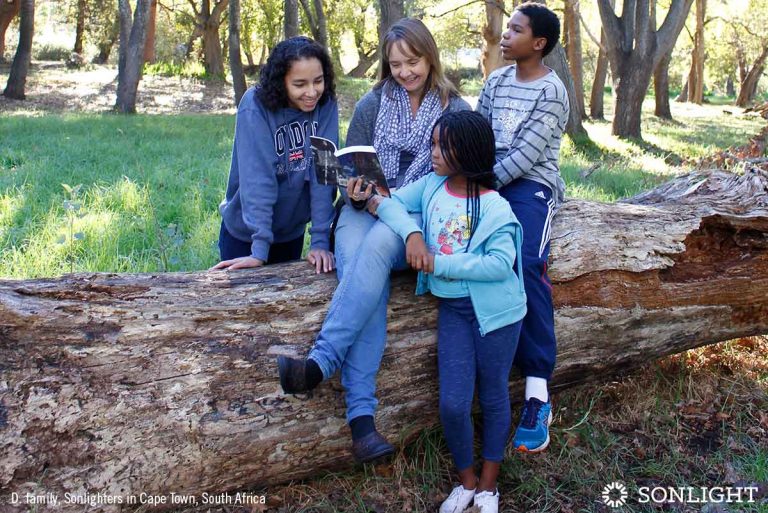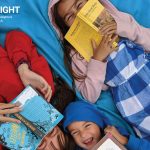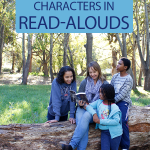
A story is more than words on a page. It’s the voices of the characters that keep readers engaged and propel the unfolding of the plot. Sonlight is a literature-rich program, and as such, there dozens of story lines and characters to keep track of in your Read-Alouds. Don’t be surprised if your child finds some books more difficult (or less interesting) than others because it is harder to keep track of the characters. If you and your children struggle to remember who is speaking or which character is which, here are three ways to keep track of and distinguish characters in your Read-Alouds.
1. Use a Different Voice for Each Character
- Using voices audibly differentiates among characters. Tightening the neck and jaw regions or lifting or lowering your neck or chin can create higher or lower pitched voices. Changing the shape of your mouth while reading changes your voice somewhat. Try speaking while smiling, grimacing, clenching teeth, or covering your teeth with your lips.
- Change the speed of your reading. Some characters are excitable and speak quickly. Others are more thoughtful or are slow talkers.
- Use accents. Think of a character from a TV show or movie that reminds you of how you think the Read-Aloud character might speak. Then mimic that accent. Don’t worry if your Dutch accent sounds more Russian, and your Russian accent comes out sounding rather French. Children won’t mind and will understand that you aren’t able to reproduce the accents authentically. Any change in accent will help them keep track of which character is talking.
- Pause to read ahead. You might need to take a break before reading dialogue to check who the character is and get your voice ready. That’s okay. Figure out who is speaking, then keep going with your voices.
- Save your ordinary voice for the main character and narrator. This trick makes it easier to keep track of what’s going on in the story. Almost all my main characters sound just like me and only the secondary characters sound like other people. If there’s more than one main character, usually the first one sounds like me.
- Use audiobooks to get ideas. Mimic the voices used in audiobooks!
- Use audiobooks as your substitute. Most of the time, I feel my children get a richer family experience by listening to me read, rather than an audiobook reader. But, there are some fantastic audiobook productions with a variety of voices that clearly portray a bevy of characters. For difficult books, having a professional reader can help your child to keep track of the different people in the story and deepen their understanding. Just make sure to listen along with your children, so you can discuss the deep concepts or the sad parts together.
Remember, the point isn’t to sound exactly the way the character ought to sound. The point is to make the listening easier on your reader. As long as the small changes in your voice help to achieve that goal, then that’s all you need.
2. Make a Chart of the Different Speakers
Instead of or in addition to using voices, a chart is a great reference tool. Use poster board, a chalkboard, a dry erase board, or even a piece of notebook paper to list the central characters. The act of making the chart is useful, and then you can refer to it regularly during Read-Aloud times.
For example, Walk the World’s Rim in History / Bible/ Literature D has a lot of Spanish characters who are very different from each other. After listing them all, we write a few words to describe each person. Here's an example of our list :
- Chakoh: Native American boy. Family starving. Eats lizards. Going to Mexico City to find his own medicine. (Main voice)
- Esteban: Esta Bien means he’s okay in Spanish. African slave. Tall and strong. Very smart. Friend to Chakoh. (Deep, strong, staccato)
- Cabeza De Vaca: Name means Head of Cow in Spanish. He’s also the head of expedition. (Less deep, very crisp, strong, authoritative)
- Dorantes: Name sounds like Doritos. Owner of Esteban. Willing to leave behind members of his team. (Whining, wheedling)
- Castillo: Name means castle in Spanish. Priest, belongs to the “castles” or large Catholic churches in Mexico. (Soft, calm, quiet)
3. Use Drawings
I find drawings, too, help my children visualize each character from a Read-Aloud.
- Draw a picture next to each name on a list. Drawings can show what the character might look like or things that remind you of their identity. For example, for Chakoh, we draw a boy or a medicine bag. For Cabeza de Vaca, we could draw a cow. For Castillo, we might draw a church that looks somewhat like a castle.
- Draw pictures of what is happening in the story during Read-Alouds time. Label the main characters to help keep them straight in the drawings. Don’t worry if the pictures look funny or aren’t entirely accurate. If they add things to the picture that aren’t in the story, they’re simply expanding the story in their mind, which shows they are internalizing the message. (A good thing!)
- Use coloring pages to go along with the stories. Besides coloring, draw or write in extra details to remember what’s going on.
- Make cartoons of the story. My children often draw cartoons with a funny punchline or that point out something funny that happened in the book. I am not a good illustrator, so when it is my turn to sketch our drawings, I rely on creative stick figures.
The main point of the drawings, or voices, or the charts isn’t to create an accurate description of every detail or point in the story. It is to help you and your children understand what is going on in the story, without getting confused. It’s okay to have fun with these tricks and make them inventive. We often draw alternate endings if we don't like the one in the book or make satirical cartoons that point out ways the thinking of the characters doesn’t make sense.
By using these tips, hopefully you can create an atmosphere where your children are able to keep track of what character is which so they can get lost in the story of their Read-Alouds.
Literature-based learning is an educational philosophy based on children's natural curiosity and love for stories. It uses outstanding books and delightful stories as the centerpiece for learning.








